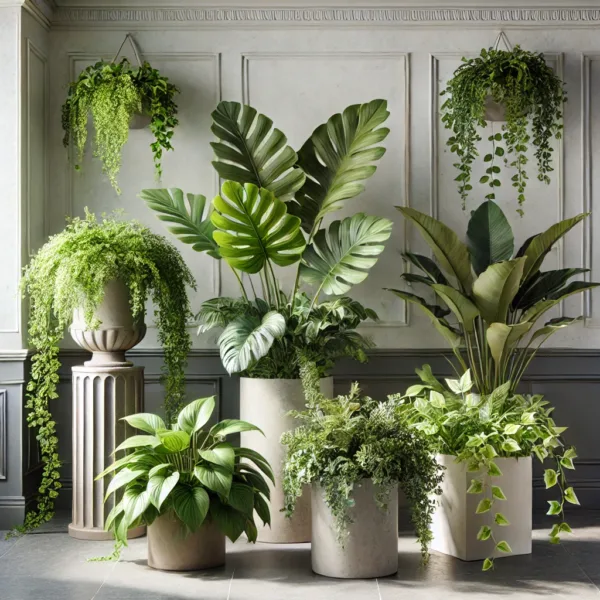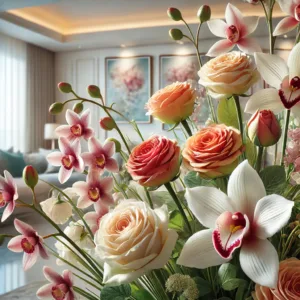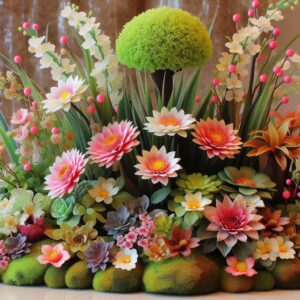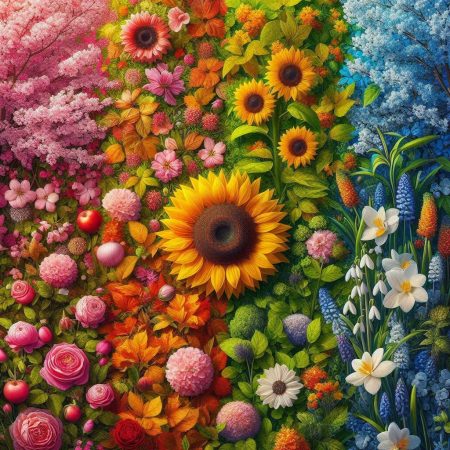
Artificial flowers and artificial plants transform any space into a year-round oasis without the maintenance. But don’t just take our word for it, in the US alone the artificial plants and flowers market is forecast to increase by over USD 380 million – growing nearly 3.5% yearly between 2024 and 2029 (Technavio artificial plants and artifical flowers US market analysis). It’s clear that the demand for artificial plants and flowers continues to grow.
So, whether you’re looking to add life to a dim corner, create a maintenance-free garden wall, or design stunning floral arrangements that last forever, this comprehensive guide will walk you through everything you need to know about selecting, styling, and maintaining artificial plants and flowers.
Introduction to Artificial Flowers and Plants

What are Artificial Flowers and Plants?
Artificial greenery refers to any plant or flower that is designed to mimic the look and feel of real greenery, but without the need for water, sunlight, or ongoing maintenance. While real plants and flowers require careful attention to grow and thrive, artificial versions are made from durable materials like silk, plastic, foam, or latex, offering the same visual appeal with far less effort.
Artificial flowers typically replicate the vibrant colors and delicate petals of real blooms, such as roses, hydrangeas, and tulips, making them ideal for bouquets or home arrangements. Artificial plants, on the other hand, include options like succulents, ferns, and trees, which are designed to imitate the texture and appearance of real foliage.
Unlike real plants that need a specific environment to flourish—such as adequate sunlight, humidity, and frequent watering—artificial greenery can thrive in virtually any setting. Whether in an office with no natural light or a home with little time for plant care, faux greenery provides an easy way to bring nature into your living spaces.
The Rise of Artificial Artificial Flowers and Plants
Gone are the days when artificial greenery meant stiff, plastic-looking foliage and uninspired designs. Modern artificial flowers and plants have undergone a remarkable transformation, becoming almost indistinguishable from their living counterparts. Advances in materials, such as silk, latex, and high-quality polymers, combined with innovative manufacturing techniques, have enabled the creation of realistic textures, intricate details, and vibrant colors that mimic the beauty of nature. Learn more about the differences of silk flowers vs plastic flowers.
This evolution has played a significant role in the growing popularity of artificial flowers. Today, these botanical replicas offer the perfect balance of elegance and practicality, making them a preferred choice for both home decorators and event planners. Whether it’s the velvety petals of a faux rose, the delicate layering of artificial hydrangeas, or the cascading vines of a hanging plant, artificial flowers now exude a lifelike charm that can fool even the most discerning eye.
Beyond their stunning appearance, artificial flowers are rising in popularity due to their versatility and convenience. They allow people to enjoy a wide variety of blooms year-round, regardless of season, and they require no water, sunlight, or maintenance. This means that even those without a green thumb can enjoy the aesthetic of lush arrangements without the worry of wilting or dying plants. Additionally, as sustainability becomes a growing concern, artificial flowers are viewed as a longer-lasting and cost-effective alternative to real blooms, particularly for weddings, events, and long-term decor.
From realistic bouquets to statement greenery pieces, artificial flowers and plants are no longer just a practical substitute—they are becoming a stylish and reliable way to bring the beauty of nature into any space.
Why Chose Artificial Flowers and Plants?

There are a wide-range of reasons to chose artificial flowers and artificial plants over traditional real plants. If you’re looking to enhance your home decor, add a touch of nature to your office, or decorate a special event, artificial greenery provides a versatile, hassle-free solution that stays vibrant and fresh all year long.
1. Low Maintenance: One of the main attractions of artificial greenery is its low-maintenance nature. Busy lifestyles, small living spaces, and the inability to care for real plants have led many people to choose faux greenery instead. With artificial flowers and plants, there’s no need to worry about watering, pruning, or worrying about wilting blooms. For more info on maintenance, check out our guide on how to clean your artificial flowers.
2. Realistic Designs: Today’s artificial greenery is more lifelike than ever before. With advancements in technology and materials, manufacturers are able to create fake plants that look remarkably similar to their real counterparts. The ability to mimic the textures, colors, and shapes of natural foliage makes artificial greenery an incredibly appealing option for home decor.
3. Versatility in Any Environment: Artificial plants and flowers can be placed in any room or setting—regardless of light conditions or humidity. Whether it’s a dimly lit office, a high-traffic area, or a bathroom with little sunlight, faux greenery can flourish. This versatility appeals to people looking to bring nature into spaces where real plants might struggle.
4. Sustainable and Long-Lasting: As sustainability becomes a growing concern, artificial greenery offers a long-lasting, eco-friendly alternative. Unlike cut flowers, which wither and are discarded after a short time, artificial flowers and plants can last for years with minimal upkeep. Many people also prefer the idea of reducing the waste associated with maintaining real plants, especially in environments where the real versions might not survive.
5. Customization and Style: Artificial greenery allows for more creativity and personalization in decorating. People can experiment with different plant types, colors, and arrangements without the constraints of nature. It’s easy to create personalized looks for every season or event, whether you’re designing a tropical oasis or a minimalist arrangement.
With each year the increasing demand for eco-conscious, low-maintenance, and realistic decor continues to drive the popularity of artificial greenery. With endless options to choose from and its effortless beauty, artificial flowers and plants have become a staple in modern homes and businesses alike.
Types of Artificial Flowers and Plants
Artificial flowers and plants come in a variety of materials, each offering unique qualities that suit different purposes, budgets, and aesthetic preferences. Here’s a quick introduction to some of the most common types along with their pros and cons:
1. Silk Flowers: The Gold Standard of Artificial Blooms
Overview:
Silk flowers are considered the premium option in the world of artificial flowers due to their incredible realism and luxurious appearance. While they are not always made of actual silk today, the term “silk flowers” has become synonymous with high-quality, fabric-based faux blooms.
Key Features:
- Realism: Silk flowers are designed to mimic the texture, appearance, and intricate details of real flowers, often using hand-painted petals and soft, flexible stems.
- Variety: Available in a wide range of colors and species, from delicate roses to exotic orchids.
- Durability: Though delicate in appearance, they are long-lasting with proper care.
Ideal For:
- High-end home decor
- Wedding bouquets and centerpieces
- Corporate spaces and luxury events
Comparison of advantages and disadvantages
| Pros | Cons |
|---|---|
| Highly realistic and elegant Suitable for both indoor and outdoor use Reusable and long-lasting | More expensive than other materials Requires occasional cleaning to prevent dust buildup Fragile compared to plastic options |
2. Plastic Plants: Affordable and Versatile Options
Overview:
Plastic plants are the most affordable and widely available type of artificial greenery. Modern manufacturing techniques have improved their design, offering more realistic textures and colors than earlier versions.
Key Features:
- Durability: Resistant to wear and tear, making them ideal for outdoor use.
- Low Maintenance: Easy to clean and maintain; can withstand exposure to sunlight and moisture.
- Flexibility: Perfect for casual home decor, retail displays, and spaces with high foot traffic.
Ideal For:
- Outdoor landscaping (e.g., faux hedges, garden borders)
- Playful or modern decor themes
- Budget-friendly solutions for homes and offices
Comparison of advantages and disadvantages
| Pros | Cons |
|---|---|
| Inexpensive and widely accessible Weather-resistant and long-lasting outdoors Lightweight and easy to transport | May lack the refined realism of silk or preserved flowers Can appear shiny or overly plastic if not of high quality Limited variety in delicate flower species |
3. Preserved Flowers: The Best of Both Worlds
Overview:
Preserved flowers are real flowers that have undergone a preservation process to maintain their natural beauty and softness while extending their lifespan. They offer the authenticity of fresh flowers with the longevity of artificial ones.
Key Features:
- Authenticity: Made from actual flowers and foliage, providing a lifelike appearance.
- Longevity: Can last months to years when kept in ideal conditions (cool, dry environment).
- Eco-Friendly: Often a more sustainable choice compared to synthetic materials.
Ideal For:
- Romantic decor (e.g., eternal rose domes)
- Keepsakes and gifts
- Upscale decor for hotels, restaurants, and events
Comparison of advantages and disadvantages
| Pros | Cons |
|---|---|
| Authentic look and feel Eco-conscious and biodegradable Minimal maintenance required | Higher price point compared to plastic or foam options Can be sensitive to humidity and direct sunlight Limited flexibility for reshaping or re-styling |
4. Foam Flowers: Lightweight and Budget-Friendly
Overview:
Foam flowers are made from soft foam material, making them lightweight, pliable, and cost-effective. They are particularly popular for DIY projects and large-scale floral decorations due to their affordability and ease of use.
Key Features:
- Lightweight: Easy to transport and install in any setting.
- Customizable: Foam flowers are often used in craft projects because they can be cut, shaped, or painted.
- Affordable: One of the cheapest options available for artificial flowers.
Ideal For:
- DIY floral arrangements and crafts
- Budget-friendly wedding or party decor
- Large-scale displays or installations
Comparison of advantages and disadvantages
| Pros | Cons |
|---|---|
| Inexpensive and easy to work with Great for crafting and large projects Available in a wide range of sizes and colors | Less realistic compared to silk or preserved flowers Can feel and look artificial up close Susceptible to tearing or denting |
Summary
Each type of artificial flower and plant serves a unique purpose, and the best choice depends on the intended use, budget, and level of realism desired:
- Silk flowers are ideal for high-end decor, weddings, and events where elegance and attention to detail are paramount. Their lifelike beauty and luxurious textures make them the perfect choice for creating an upscale atmosphere.
- Plastic plants are perfect for durable, everyday use in high-traffic or outdoor areas, where resilience is key. Modern plastic designs have improved greatly, offering a realistic look at an affordable price.
- Preserved flowers are a fantastic option for those seeking the authenticity of real blooms with extended longevity. They bring a timeless charm to sentimental keepsakes and upscale arrangements, making them a favorite for romantic or special occasions.
- Foam flowers are excellent for DIY enthusiasts and large-scale creative projects. Lightweight and easy to customize, they are ideal for crafting vibrant, budget-friendly floral installations.
By understanding the strengths, aesthetics, and limitations of each material, you can confidently choose the right artificial flowers and plants to match your vision and enhance any space beautifully.
Choosing Your Artificial Flowers and Plants
When it comes to selecting artificial flowers and plants, it’s essential to consider your personal style, the purpose of the arrangement, and the space it will enhance. Modern artificial flowers offer incredible realism and versatility, making them perfect for every occasion—from home decor to weddings. Here’s how to choose the right faux blooms for your needs.
Matching Artificial Flowers and Plants to Your Style
Your artificial flowers should reflect your aesthetic preferences and the vibe you want to create. Whether you’re aiming for a minimalist, bohemian, rustic, or elegant look, there are faux flowers that can help you achieve it. For example:
- Minimalist Style: Opt for simple blooms like white roses or lilies in a neutral palette.
- Rustic Style: Choose wildflowers, daisies, or sunflowers paired with earthy tones.
- Elegant Style: Consider luxurious faux flowers like orchids or peonies for a timeless, sophisticated feel.
Consider the Space and Purpose
Where and how you plan to use your artificial flowers or plants will influence your choice.
- For Home Decor: Select blooms that complement your room’s color scheme and size. Large arrangements with statement flowers like hydrangeas or magnolias can make an impact in living rooms, while small, subtle flowers work well for bathrooms or bedrooms.
- For Events or Weddings: Choose flowers that align with the theme of the occasion. For weddings, faux roses, tulips, and baby’s breath are timeless classics.
- For Outdoor Use: Ensure the materials are UV-resistant to prevent fading in the sun, especially for outdoor displays or porch arrangements.
If you are looking for more info about choosing the right artificial plants for your home, check another one of our guides on how to pick the right artificial plants for home decor.
Choosing The Right Vase for your Artificial Flowers and Plants
When it comes to displaying artificial flowers, the vase you choose is just as important as the blooms themselves. The right vase not only enhances the beauty of your artificial plants arrangement but also ensures that it fits seamlessly into your space, complementing your decor style. Artificial flowers offer unmatched flexibility, as their wired stems allow you to bend or trim them to achieve the perfect height and shape. However, we often recommend bending over cutting, as this preserves the stems for reuse in future arrangements.
Consider the Style and Purpose of Your Arrangement
The type of vase you choose depends largely on the arrangement you’re creating and where you plan to display it. Artificial flowers offer incredible versatility, whether you’re creating a bold centerpiece, a casual meadow-inspired display, or a minimalist arrangement.
- For Compact Floral Arrangements: Choose vases with narrow necks or opaque finishes to conceal the stems and draw attention to the flowers themselves.
- For Natural, Rustic Displays: Consider vases with textured finishes or earthy tones to highlight the lifelike qualities of your faux flowers.
- For Heightened Elegance: Tall, clear glass vases can emphasize branch-like stems or delicate blossoms, showcasing their length and creating drama.
Get Creative with Your Display
One of the greatest advantages of working with artificial flowers is the creative freedom they offer. Unlike real flowers, faux blooms don’t need water, so you’re not limited to traditional vases. Think outside the box and experiment with unconventional vessels to make your arrangements stand out.
- Baskets: Fill a woven basket with faux flowers for a textured, rustic look. This contrast between soft blooms and natural fibers adds depth and intrigue to your decor.
- Vintage Finds: Repurpose antique pitchers, jars, or tins as vases for a unique, one-of-a-kind display.
- Unusual Shapes: Geometric vases or asymmetrical vessels can add a modern edge to your artificial flower arrangements, creating a conversation starter in any room.
By using these creative approaches, you can personalize your displays and bring new life to your artificial flowers.
Conclusion: Transform Your Space with Artificial Flowers and Plants
Artificial flowers and plants are no longer just an alternative to real greenery—they have become a design staple in their own right, offering endless possibilities for enhancing any space. With their lifelike appearance, low-maintenance nature, and year-round availability, they provide a practical yet stylish way to bring the beauty of nature indoors.
Whether you’re looking to refresh your home decor, create a welcoming office environment, or design a show-stopping event, artificial greenery offers the versatility to suit any style or need. From vibrant flower arrangements that add a pop of color to your living room to lush faux plants that bring life to low-light corners, the right artificial greenery can completely transform your space.
Ready to Transform Your Space?
Now is the perfect time to explore the world of artificial flowers and plants. With advancements in design and materials, you can achieve the look and feel of natural greenery without the upkeep. Start small with a statement piece or dive in with a complete arrangement—whatever your choice. Durable, realistic, and endlessly customizable, artificial greenery brings timeless beauty and effortless charm to any space, ensuring it always looks its best.



Comments are closed